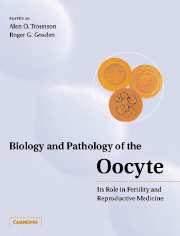Book contents
- Frontmatter
- Contents
- List of contributors
- Preface
- Part I Historical perspective
- Part II Life cycle
- Part III Developmental biology
- Part IV Pathology
- 13 Morphology and pathology of the human oocyte
- 14 The legacy of mitochondrial DNA
- 15 Aneuploidy in ageing oocytes and after toxic insult
- 16 Genetic basis of primary ovarian failure
- Part V Technology and clinical medicine
- Index
14 - The legacy of mitochondrial DNA
from Part IV - Pathology
Published online by Cambridge University Press: 05 August 2016
- Frontmatter
- Contents
- List of contributors
- Preface
- Part I Historical perspective
- Part II Life cycle
- Part III Developmental biology
- Part IV Pathology
- 13 Morphology and pathology of the human oocyte
- 14 The legacy of mitochondrial DNA
- 15 Aneuploidy in ageing oocytes and after toxic insult
- 16 Genetic basis of primary ovarian failure
- Part V Technology and clinical medicine
- Index
Summary
Introduction
Most eukaryotic cells rely on ATP produced by oxidative phosphorylation for their normal function. This process requires the activity of five multisubunit enzyme complexes located in the inner mitochondrial membrane. Electron transport along complexes I-IV of the respiratory chain creates an electrochemical gradient for protons, which is used to drive the synthesis of ATP from ADP and inorganic phosphate by complex V, ATP synthetase. These multimeric complexes are unique in the cell in that the component polypeptide subunits are encoded by both the nuclear and mitochondrial (mtDNA) genomes. Of the approximately 80 structural subunits of oxidative phosphorylation, 13 are mtDNA-encoded, and all are essential for function.
It has long been established that mtDNA is maternally inherited in mammals (Giles et al., 1980). As mitochondria are not made de novo, but rather only elaborated from other mitochondria, all of our mitochondria ultimately derive from those in one of our mother's oocytes. Paternal mitochondria containing mtDNA are present in the early embryo; however, they are rapidly degraded by a process that remains poorly understood.
Mutations in mtDNA in humans are an important cause of a group of multisystem disorders usually referred to as mitochondrial encephalomyopathies because of the prominent involvement of the nervous system and striated muscle (Wallace, 1999; Schon, 2000; DiMauro and Schon, 2001). The minimum prevalence of these disorders has been estimated at about 1:8000 in a Caucasian population in northern England (Chinnery et al., 2000a). The rules governing the transmission and segregation of mtDNA in the female germline have thus taken on a renewed importance for genetic counselling and the clinical management of patients affected by these disorders. Further, the introduction of new reproductive technologies, such as cytoplasmic transfer, direct intracytoplasmic sperm injection (ICSI) and animal cloning, have forced a re-evaluation of the potential contribution of exogenous or paternally derived mitochondria to the next generation. In this chapter, the current knowledge in these areas will be reviewed.
Mitochondrial DNA: structure, replication and expression
The mtDNA of all mammals investigated has the same basic structure: a double-stranded circular DNA molecule of ∼16.5 kilobases (kb) (Figure 14.1). The two strands are referred to as heavy (H) and light (L) reflecting their behaviour in caesium chloride (CsCl) density gradients.
- Type
- Chapter
- Information
- Biology and Pathology of the OocyteIts Role in Fertility and Reproductive Medicine, pp. 209 - 219Publisher: Cambridge University PressPrint publication year: 2003

